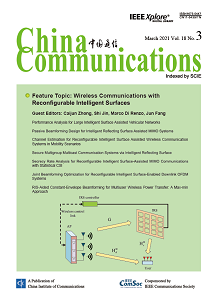NETWORKS & SECURITY
Yong Wang, Weiwei Yang, Tao Zhang, Yong Chen, Xiaohui Shang, Quan Wang
2021, 18(3): 155-173.
This paper investigates secure transmission in a wireless powered communication network (WPCN) with an energy harvesting (EH) source configured with multiple antennas. In the WPCN, the EH source harvests energy from the radio frequency (RF) signals broadcasted by a power beacon (PB), and purely relies on the harvested energy to communicate with the destination in the presence of passive eavesdroppers. It is noteworthy that the RF-EH source is equipped with a finite energy storage to accumulate the harvested energy for the future usage. Moreover, due to energy-constraint and complexity-limitation, the multi-antenna source is only configured with a single RF-chain. To enhance the security for the WPCN, we propose two adaptive transmission schemes, i.e., energy-aware transmit antenna selection (EATAS) and energy-aware differential spatial modulation (EADSM). According to the energy status and the channel quality, the source adaptively decides whether to transmit confidential information or harvest RF energy. To evaluate the secrecy performance of the proposed schemes, we first study the evolution of the energy storage, and then derive the analytical expressions of connection outage probability (COP), secrecy outage probability (SOP) and efficient secrecy throughput (EST). Numerical results demonstrate that our proposed schemes outperform the existing schemes, i.e., time-switching based TAS (TS-TAS) and accumulate-then-transmit (ATT). And, increasing the transmit power of the PB or the capacity of the source's energy storage is helpful to improve the secrecy performance. Moreover, there exists an optimal transmission rate for each proposed scheme to achieve best secrecy performance.
